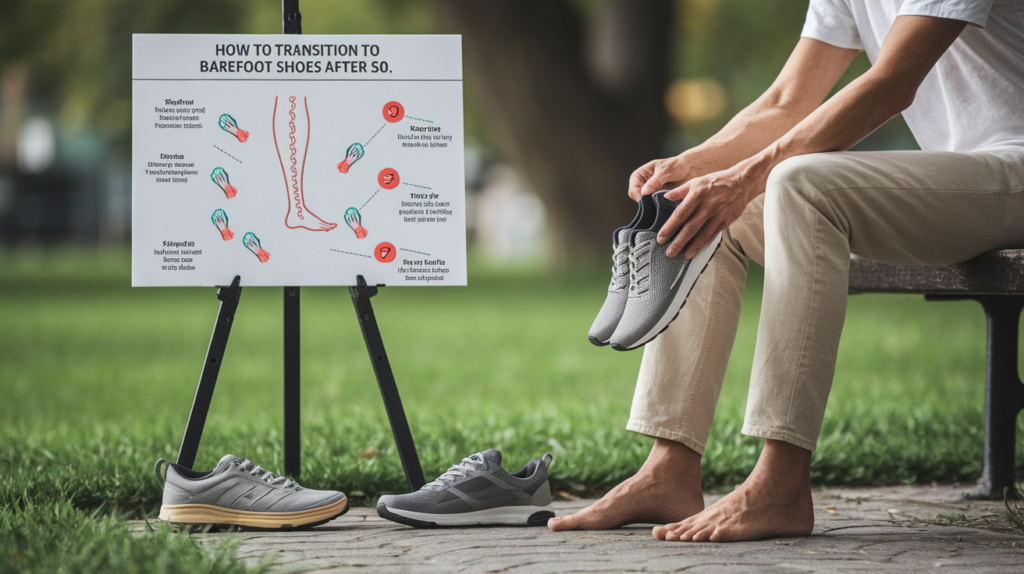
Transitioning to barefoot shoes after 50 can feel daunting, but with the right approach, it’s a rewarding journey for your feet and overall health. Start slowly, as your muscles and joints need time to adapt after years of traditional footwear—think of it as training wheels for your feet. Focus on short walks first, gradually increasing duration to avoid strain. Pay attention to proper form, like landing midfoot, to reduce injury risk. Over time, you’ll notice improved balance, stronger arches, and better posture. Listen to your body, and celebrate small wins along the way.
Understanding Barefoot Shoes
To embrace barefoot shoes is to reconnect with your natural stride. These minimalist designs mimic walking barefoot while offering light protection, encouraging better posture, stronger foot muscles, and improved balance. For those over 50, this transition can feel daunting, but think of it as training wheels for your feet – start slow, build strength.
What Are Barefoot Shoes?
Across brands and styles, barefoot shoes share a common philosophy: zero drop (no heel elevation), thin soles for ground feedback, and a wide toe box to let toes splay naturally. Unlike traditional footwear, they prioritize foot mobility over cushioning or support.
Benefits of Barefoot Shoes
Shoes with minimalist designs can strengthen arches, reduce joint strain, and enhance proprioception (your body’s awareness of movement). Many wearers report fewer aches and improved gait over time.
Considering the shift? Research suggests barefoot shoes may lower injury risks by promoting a midfoot strike instead of heel striking. They also encourage better circulation and toe alignment, which is especially helpful if you’ve worn narrow shoes for decades.
Key Features to Look For
Behind every quality barefoot shoe are these vitals:
- Flexible soles – Bend and twist like your foot naturally would.
- Wide toe box – No cramped toes; space for splaying.
- Zero-drop design – Flat from heel to toe for proper alignment.
- Lightweight materials – Avoids restricting movement.
This ensures your feet adapt comfortably.
The right pair should feel like a second skin, not a constraint. Avoid rigid soles or arch support, as these defeat the purpose. Look for breathable fabrics to prevent overheating, and check for durable stitching if you’re active. This attention to detail makes the transition smoother.
The Importance of Transitioning Gradually
One of the most overlooked steps when switching to barefoot shoes is taking your time. Your feet and lower limbs need weeks or even months to adapt after decades of wearing supportive footwear. Think of transitioning as training wheels for your feet – start slow, build strength. Rushing the process can lead to discomfort or injury, especially after 50, when your body’s resilience isn’t what it once was. Begin with short walks, gradually increasing duration as your muscles and joints adjust. Patience here pays off in long-term comfort and mobility.
The Risks of Abrupt Transition
Importance of avoiding a sudden switch cannot be overstated. Jumping straight into barefoot shoes can strain your arches, calves, and Achilles tendons, leading to pain or even stress fractures. Your feet rely on decades of muscle memory from cushioned soles, and shocking them with immediate change risks setbacks. Listen to your body—if you feel sharp discomfort, scale back. A slow transition lets your tissues adapt safely, reducing the chance of overuse injuries.
Age-Related Foot Changes
With age, your feet naturally lose padding, flexibility, and muscle tone. Arches may flatten, and joints stiffen, making traditional shoes feel more comfortable—but often at the cost of weakening foot mechanics. Barefoot shoes encourage natural movement, but your feet need time to relearn how to support themselves without artificial cushioning.
Consequently, ignoring these changes can worsen existing issues like plantar fasciitis or arthritis. Barefoot shoes can help rebuild strength, but only if introduced carefully. Focus on gentle exercises—toe spreads, short barefoot walks—to reactivate dormant muscles before committing to all-day wear.
Physiological Adaptations to Barefoot Shoes
On a biological level, your feet and legs undergo remarkable changes when transitioning. Your arches strengthen, toe splay improves, and proprioception (awareness of ground contact) sharpens. Blood flow increases as muscles engage more dynamically, reducing stiffness common in later years.
Gradually, these adaptations lead to better balance, fewer aches, and a more natural gait. However, pushing too fast can backfire—tendons and ligaments need time to lengthen. Pair your transition with foot-strengthening exercises, like calf raises or marble pickups, to speed up adaptation safely. The reward? A foundation that feels younger and more resilient.
Pre-Transition Assessment
After turning 50, your feet may need extra care when switching to barefoot shoes. This phase helps you understand your readiness by evaluating foot health, consulting experts, and reviewing past footwear. Think of transitioning as training wheels for your feet – start slow, build strength.
Evaluating Personal Foot Health
Assessment begins with checking your foot strength, flexibility, and any existing conditions like plantar fasciitis or bunions. Notice how your feet feel after walking barefoot at home—discomfort or fatigue signals a need for gradual adaptation.
Consulting with Healthcare Professionals
Before making the switch, discuss your plan with a podiatrist or physiotherapist. They can identify potential risks, such as joint instability, and recommend exercises to ease the transition.
In fact, professionals often highlight hidden issues like poor arch support dependence or muscle atrophy. Their guidance ensures you avoid injuries while embracing barefoot shoes safely.
Footwear History Review
To prepare, examine your past shoes—stiff soles or high heels may have weakened foot muscles. Transitioning too fast from supportive shoes can strain tendons, so note patterns like frequent ankle rolls.
Also, arch support dependency is common after decades of cushioned shoes. Recognizing this helps tailor your transition pace, preventing setbacks like stress fractures or overuse pain.
Phase 1: Initial Transition (Weeks 1–4)
Many people over 50 find the shift to barefoot shoes exciting but challenging. Start by wearing them for just 1–2 hours daily to let your feet adapt without strain. Your muscles and joints need time to adjust after years of cushioned support. Think of transitioning as training wheels for your feet – start slow, build strength. Avoid long walks or intense activities during this phase to prevent discomfort or injury.
Selecting the Right Barefoot Shoes
Beside style, prioritize flexibility, zero-drop soles, and a wide toe box for natural foot movement. Look for brands specializing in barefoot shoes, as they offer proper support for your transition. Ill-fitting shoes can delay progress or cause pain, so ensure a snug but not tight fit. Test them indoors first to confirm comfort.
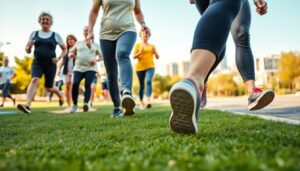
Light Activities to Begin
Among the best starters are short walks, standing exercises, or gentle yoga. Focus on low-impact movements to awaken dormant foot muscles without overloading them. Keep sessions under 30 minutes initially.
Due to your feet’s reduced strength from years of conventional shoes, overdoing it early risks strains or stress fractures. Gradually increase activity only if you feel no lingering soreness. Listen to your body – discomfort is normal, but pain is a warning.
Building Awareness of Foot Sensations
Before increasing intensity, practice noticing how your feet interact with the ground. Walk barefoot on safe surfaces like grass or carpet to reconnect with natural movement patterns. This mindfulness prevents bad habits like heel-striking.
Right technique matters more than speed. Landing softly on your midfoot reduces joint impact, while toe splaying improves balance. If you feel sharp pain or numbness, stop immediately – these signal potential injury. Celebrate small wins, like improved posture or less stiffness.
Phase 2: Gradual Increase (Weeks 5–8)
All progress in your barefoot transition should be steady and mindful. By now, your feet are adapting, so aim to wear your barefoot shoes for 4–6 hours daily, including short walks. Avoid overexertion—listen to your body and scale back if you feel discomfort. This phase builds endurance while letting your muscles and joints adjust naturally. Think of it as training wheels for your feet; you’re gaining confidence but still need patience.
Strengthening Exercises for Older Adults
Against stiffness or weakness, simple exercises like toe spreads, calf raises, and ankle circles can boost foot strength. Perform these daily to improve flexibility and stability. Focus on slow, controlled movements to prevent strain. These exercises mimic natural barefoot movement, preparing your feet for longer wear.
Incorporating More Walking Time
Among daily activities, gradually add 10–15 minutes of walking in barefoot shoes. Start on soft surfaces like grass or carpet to reduce impact. Your goal is to build tolerance without pushing too hard.
Further, track your steps or distance to monitor progress. Pain is a warning sign—if you feel sharp discomfort, reduce walking time. Consistency matters more than intensity; small increases yield lasting results.
Recognizing Comfort Levels
About your comfort, pay attention to how your feet feel during and after wear. Mild soreness is normal, but persistent pain means you’ve pushed too far. Adjust your routine accordingly.
Hence, prioritize proper fit and gradual adaptation. Barefoot shoes should feel freeing, not forced. If discomfort lingers, consult a specialist to ensure your transition stays safe and effective.
Phase 3: Full-Day Wear (Weeks 9–12)
Keep wearing your barefoot shoes for longer periods, aiming for full-day use by week 12. Your feet and lower legs should now feel stronger, but listen to your body—if discomfort arises, scale back. This phase solidifies your adaptation, so prioritize surfaces like grass or carpet initially to ease strain. Overdoing it too soon can lead to injuries, so patience remains key. Think of transitioning as training wheels for your feet—steady progress ensures lasting success.
Transitioning to Daily Use
Any extended wear should feel natural by now, but avoid high-impact activities until your muscles fully adjust. Rotate between barefoot and supportive shoes if needed, especially after long days. Your gait will refine over time, so focus on landing softly and distributing weight evenly. This gradual shift helps prevent overuse injuries while reinforcing proper movement patterns.
Dynamic Exercises and Their Importance
With stronger feet, incorporate dynamic exercises like toe spreads, calf raises, or balance drills to enhance mobility. These movements activate underused muscles and improve proprioception, reducing fall risks. Aim for 5–10 minutes daily to maintain progress.
Dynamic exercises aren’t just about strength—they retrain your nervous system for better coordination. Skipping them can delay adaptation, leaving you prone to stiffness or strain. Simple routines, like walking on uneven terrain, mimic natural movement and boost joint resilience, vital for long-term comfort in barefoot shoes.
Continual Assessment and Adjustment
For ongoing success, regularly check for signs of overuse, such as persistent soreness or swelling. Adjust wear time or intensity immediately if these occur. Your transition isn’t linear—factors like terrain or fatigue demand flexibility in your approach.
Consequently, staying attuned to your body prevents setbacks. Ignoring pain signals risks serious injury, while mindful adjustments foster steady improvement. Celebrate small wins, like increased stamina or reduced discomfort, as proof your feet are adapting well.
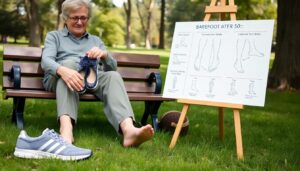
Common Challenges During Transition
Unlike traditional shoes, barefoot footwear requires your feet and legs to adapt to a new way of moving. You may experience calf tightness, foot fatigue, or even hesitation as your body adjusts. These challenges are normal and signal your muscles are strengthening. Think of transitioning as training wheels for your feet—start slow, build strength, and listen to your body to avoid overuse injuries.
Dealing with Calf Tightness
About half of new barefoot shoe wearers report calf tightness, as your lower legs work harder without heel elevation. Stretch gently after walks, roll your calves with a foam roller, and shorten your stride to reduce strain. This discomfort usually fades within weeks as your muscles adapt.
Managing Foot Fatigue
The sudden increase in foot muscle engagement can leave your arches tired. Limit initial wear to 1-2 hours daily, alternating with supportive shoes. Walking on varied surfaces like grass or sand helps strengthen feet gradually while minimizing fatigue.
With consistent wear, your foot endurance improves. If fatigue persists beyond 4 weeks, consult a podiatrist—it may indicate underlying weakness or improper form. Ice and massage can ease temporary soreness.
Addressing Hesitation or Fear
During the transition, you might worry about stability or joint impact. Start indoors or on smooth paths to build confidence. Many over-50 beginners find barefoot shoes actually improve balance once adapted.
And if fear lingers, try hybrid minimalist shoes first. Studies show transitioning reduces fall risk long-term by enhancing proprioception. Pairing barefoot shoes with toe exercises accelerates adaptation safely.
Strategies for Successful Adaptation
Unlike traditional shoes, barefoot footwear requires a gradual approach to avoid strain. Start with short walks, increasing duration as your feet strengthen. Think of transitioning as training wheels for your feet – slow progress prevents injury while rebuilding natural mobility. Rotate barefoot shoes with supportive pairs initially, allowing muscles to adapt without overloading them.
Listening to Your Body
Against the urge to push through discomfort, pay attention to signals like soreness or fatigue. Discomfort is normal, but sharp pain means you’re moving too fast. Adjust your pace or revert to supportive shoes temporarily—your body’s feedback is your best guide.
Setting Realistic Goals
Between excitement and impatience, aim for small, measurable targets, like wearing barefoot shoes for 30 minutes daily. Over weeks, increase time and activity level. Rushing can lead to setbacks, while consistency builds lasting strength.
It helps to track progress in a journal or app. Note improvements in balance or reduced stiffness—these signs confirm your feet are adapting. If progress stalls, reassess without frustration; adaptation varies by individual.
Celebrate Small Milestones
Along the way, acknowledge achievements like your first barefoot walk around the block. Recognizing progress boosts motivation and reinforces positive habits, making the transition feel rewarding rather than daunting.
Goals like these keep you engaged. Share milestones with a community or loved ones—supportive accountability turns challenges into victories. Every step forward, no matter how small, is a win for your long-term foot health.
Case Studies and Testimonials
For inspiration, here are real-world examples of individuals over 50 who successfully transitioned to barefoot shoes:
- Susan, 52: Reduced chronic plantar fasciitis pain by 80% within 6 months, walking 5,000+ steps daily.
- Mark, 58: Improved balance and eliminated knee stiffness after 4 months, transitioning from rigid orthopedic shoes.
- Linda, 65: Regained natural arch strength in 8 months, reporting fewer falls and increased hiking endurance.
Real-Life Experiences of Older Adults
Before making the switch, many worry about discomfort or instability. Yet, stories like Robert’s, 60, who went from avoiding walks due to ankle pain to completing 3-mile hikes, prove gradual adaptation works. Think of transitioning as training wheels for your feet – start slow, build strength.
Impact on Mobility and Pain Reduction
Reduction in joint pain and improved mobility are common themes. Users report less lower back pain and better toe alignment, as barefoot shoes encourage natural movement patterns.
Indeed, studies suggest minimalist footwear can enhance proprioception (body awareness), reducing fall risks. One 2022 trial found older adults wearing barefoot shoes had 15% better balance scores after 12 weeks.
Lessons Learned from Transitioning
Any transition requires patience. Overdoing it early can lead to soreness, while ignoring foot fatigue may cause setbacks. Listen to your body – progress in weeks, not days.
To avoid pitfalls, prioritize short wear sessions (20-30 minutes initially) and foot-strengthening exercises. Those who rushed the process often experienced temporary discomfort, while gradual adopters saw long-term benefits faster.
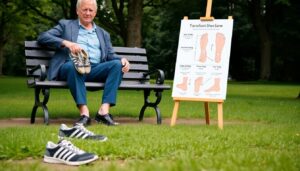
Expert Opinions
Once again, transitioning to barefoot shoes after 50 is supported by experts who emphasize gradual adaptation to avoid injury. Think of it as training wheels for your feet – start slow, build strength. Professionals agree that listening to your body is key, and patience will help you reap the benefits of improved posture, balance, and foot health.
Insights from Podiatrists
One common advice from podiatrists is to strengthen your foot muscles before fully switching. They warn against rushing the process, as overuse injuries can occur if you abandon supportive shoes too quickly. Custom orthotics may still be needed temporarily for some individuals.
Experiences of Physical Therapists
Therapists highlight that barefoot shoes can improve gait mechanics and reduce joint strain over time. Many clients report less knee and hip pain, but they stress the importance of proper alignment during the transition.
In addition, physical therapists recommend targeted exercises like toe spreads and calf stretches to ease the shift. They note that weak arches or prior injuries may require extra attention, so consulting a professional ensures a safer transition.
Recommendations from Footwear Experts
Beside choosing minimalist designs, experts suggest prioritizing flexibility and a wide toe box to allow natural movement. They caution against thin soles if you’re new to barefoot shoes, as thicker transitional models can help your feet adjust.
Even seasoned wearers should rotate barefoot shoes with traditional ones initially. Footwear specialists warn that ignoring discomfort can lead to stress fractures, so progress at your own pace and prioritize quality over style.
Frequently Asked Questions
Not sure where to start with barefoot shoes? You’re not alone. Many people over 50 have questions about the transition, benefits, and practicality of minimalist footwear. Below, we address the most common concerns to help you make an informed decision and ease into this new chapter of foot health.
Is It Difficult to Transition Later in Life?
With patience and the right approach, transitioning to barefoot shoes after 50 is entirely possible. Your feet may need time to adapt after decades in supportive footwear, but think of it as training wheels for your feet – start slow, build strength, and listen to your body. Many older adults find the process rewarding as they regain natural mobility.
How Do I Know If Barefoot Shoes Are Right for Me?
Around half of new wearers notice immediate improvements in posture or foot comfort. If you struggle with foot pain, stiffness, or balance issues, barefoot shoes could help by encouraging proper alignment and strengthening your arches. Try short walks first to gauge your response.
Due to the unique needs of older feet, consult a podiatrist if you have severe arthritis, neuropathy, or prior injuries. Barefoot shoes aren’t a one-size-fits-all solution, but they often benefit those seeking a more natural stride.
Can I Still Wear Traditional Shoes Occasionally?
Wear traditional shoes when needed, but be mindful of sudden switches that may strain your feet. Occasional use won’t undo progress, but relying on them too often can slow your adaptation. Opt for minimalist styles with wider toe boxes when possible.
Also, avoid high heels or rigid soles during your transition phase, as they can counteract the benefits of barefoot shoes. Your feet thrive on consistency, so prioritize minimalist footwear for daily activities to maximize results.
Special Considerations for Health Conditions
Now, if you have underlying health conditions, transitioning to barefoot shoes requires extra care. Consult your healthcare provider before starting, especially if you have arthritis, diabetes, or balance issues. Your feet may need a slower, more tailored approach to avoid discomfort or injury. Listen to your body and adjust your transition plan as needed—this isn’t a race but a journey toward stronger, healthier feet.
Considerations for Arthritis and Foot Deformities
Beside arthritis or foot deformities like bunions, barefoot shoes can still work for you, but patience is key. Start with minimalist shoes offering slight cushioning or wider toe boxes to reduce pressure. Gradually increase barefoot time as your joints adapt. If pain persists, scale back and seek professional advice—forcing adaptation can worsen symptoms.
Adapting Transition Plans for Diabetes
Below diabetes, foot sensitivity and circulation issues demand caution. Inspect your feet daily for blisters or sores, as numbness may mask injuries. Opt for soft, flexible barefoot shoes with seamless interiors to minimize friction. Transition slower than usual—even a few minutes daily—to avoid undue stress.
Also, diabetes slows healing, so preventing injuries is critical. Pair barefoot shoes with moisture-wicking socks to reduce infection risks. If you notice redness or swelling, pause the transition and consult your podiatrist immediately.
Balance and Coordination Concerns
The shift to barefoot shoes can challenge balance, especially if you’re new to minimal support. Begin on stable surfaces like carpet or grass before progressing to uneven terrain. Strengthen your ankles and calves with simple exercises to build stability over time.
Considerations for balance include using a cane or wall for support during early transitions. Falls are a real risk, so prioritize safety—progress only when you feel confident. Over time, your proprioception will improve, enhancing natural movement.
Tips for Long-Term Success with Barefoot Shoes
For lasting comfort and strength in barefoot shoes, gradual adaptation is key.
- Rotate between traditional and barefoot shoes to ease your feet into the change.
- Focus on proper walking form, landing softly on your midfoot.
- Strengthen your feet with toe spreads and calf stretches to prevent strain.
The more consistently you wear them, the better your feet will adapt to the natural movement.
Maintaining Foot Health
Before committing to barefoot shoes, check for calluses, blisters, or discomfort. Massage your feet regularly and soak them in warm water to relieve tension. Listen to your body—if pain persists, reduce wear time or consult a specialist. The goal is to build resilience without overloading your feet.
Incorporating Foot Mobility Workouts
Shoes alone won’t transform your foot strength—pair them with mobility exercises. Try toe yoga, ankle circles, or picking up marbles to enhance flexibility. These small habits reinforce your transition and prevent stiffness.
In fact, studies show that foot mobility work improves balance and reduces injury risk, especially after 50. Dedicate 5-10 minutes daily to these exercises, and you’ll notice smoother strides in your barefoot shoes.
Staying Informed About Footwear Developments
Informed choices ensure you benefit from the latest barefoot shoe innovations. Follow reputable brands, read reviews, and join communities to share experiences. Avoid outdated designs that lack proper toe space or sole flexibility.
With the market evolving, some brands now offer transitional models with slight cushioning—ideal if you need extra support. However, beware of imitations labeled “minimalist” but still restrictive. Always prioritize your foot’s natural movement.
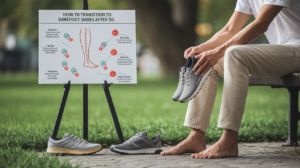
To wrap up
So, transitioning to barefoot shoes after 50 is like training wheels for your feet – start slow and build strength. Begin with short walks, gradually increasing time as your muscles adapt. Pair this with foot exercises to improve flexibility and balance. Listen to your body, allowing it to adjust at its own pace. Over time, you’ll notice better posture, stronger feet, and a more natural stride. Your journey to minimalist footwear is about patience and consistency, not speed. With the right approach, you’ll enjoy the benefits of barefoot shoes while minimizing discomfort. Keep moving forward, one step at a time.
FAQ
Is it safe to switch to barefoot shoes after 50, especially if I have joint concerns?
Absolutely! Many people over 50 successfully transition to barefoot shoes with patience. Think of it as training wheels for your feet – start slow, build strength. Barefoot shoes encourage natural movement, which can improve joint mobility over time. If you have specific conditions like arthritis, consult a podiatrist first, but gradual adaptation often helps strengthen feet and ankles.
How long does it take to adjust to barefoot shoes, and what’s the best way to start?
Adaptation varies, but most people need 3–6 months for full comfort. Begin by wearing barefoot shoes for short periods (30–60 minutes daily), like during walks or at home. Pair this with foot-strengthening exercises (toe spreads, calf raises) to speed up the process. Your feet have spent decades in supportive shoes, so treat this as a gentle reawakening of their natural function.
Will barefoot shoes help with balance and posture as I age?
Yes! Barefoot shoes enhance proprioception (your body’s awareness of movement), which supports better balance and posture. The thin soles allow your feet to “feel” the ground, improving stability—like upgrading from a wobbly chair to a steady foundation. Many older adults report fewer trips and stronger alignment after switching, but consistency is key for lasting benefits.


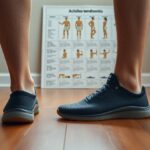
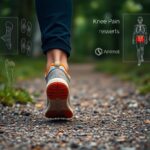
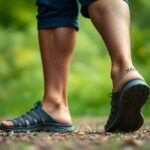
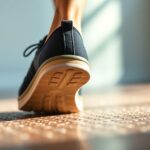
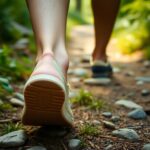

Transitioning to barefoot shoes after 50? Now that’s a journey I can relate to! It’s like trying to remember how to ride a bike after a few decades of driving—slightly terrifying but full of potential for newfound freedom!
Transitioning to barefoot shoes after 50 really resonates with me. I’ve been exploring this journey over the past few months, and while the initial challenge seemed daunting, the benefits have been worth the effort. It’s striking how much our bodies can adapt when we approach change with patience. I remember my first few weeks; I could only do short strolls around the block. Each little increase in distance felt like an achievement, and noticing the development in my foot strength was fascinating.
It’s interesting to consider how our foot health often gets overlooked as we age, especially regarding footwear choices. Transitioning to barefoot shoes certainly aligns with the broader trend towards minimalism and a more natural connection to our environment, not just for our feet but in lifestyle choices overall.
Transitioning to barefoot shoes after 50 resonates with me on so many levels. I can relate to that moment of hesitation when considering a significant shift in footwear—it feels like such a daunting leap, especially after years of relying on more structured, traditional shoes! But as you mentioned, it’s really about taking those first small steps.
I appreciate your insights on transitioning to barefoot shoes after 50. It’s true that the journey can be challenging, but it’s fascinating to think about how reconnecting with our natural stride can enhance overall health. I made the switch a couple of years ago, and I remember starting with short, gentle walks just as you suggested. I found that focusing on my posture and landing midfoot made a noticeable difference in how my body felt afterward.
Ah, the great barefoot shoe transition—it’s akin to teaching an old dog (or in this case, a well-worn human foot) a new trick! Welcome to the flip-flop lifestyle… just without the flip-flop part. I love how you describe the journey as being like training wheels for our feet; it really captures that delicate balance of excitement and trepidation we feel when stepping (quite literally) into new territory.